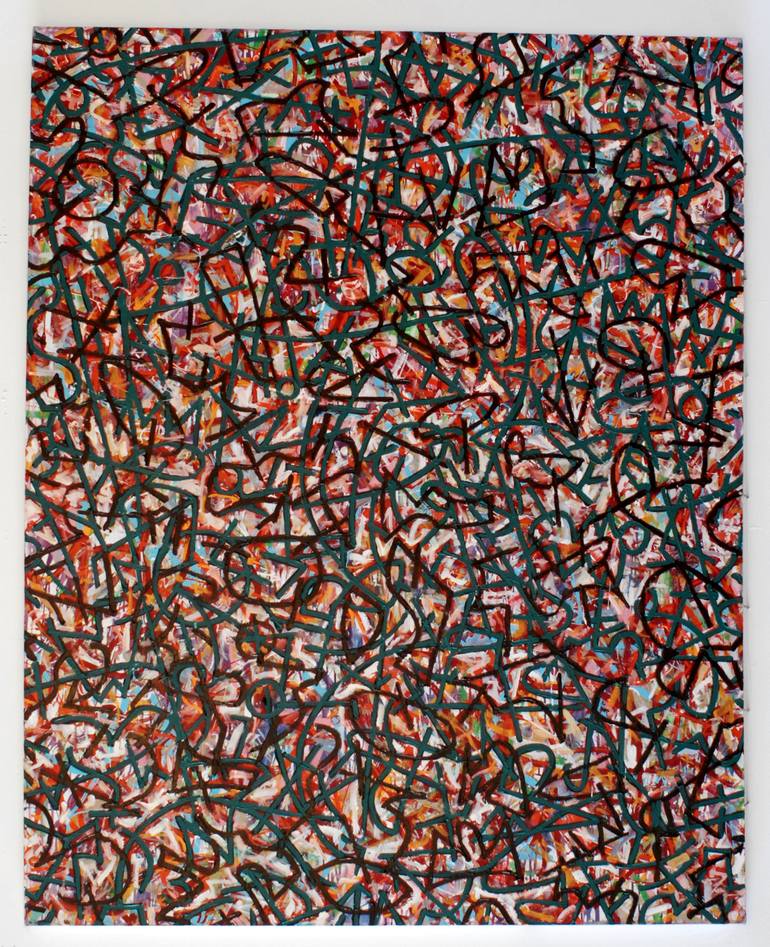





VIEW IN MY ROOM
Writing of Light, 9 - Nora Print
Germany
Select a Material
Fine Art Paper
Select a Size
8 x 10 in ($80)
Add a Frame
White ($80)
About The Artwork
In this painting, I went back to investigating how firmness can be established through movement. There is a return to the immense hardness of surface, and the razor-like power of the edge. Once again, the edge is fully integrated with, and supports, the hard surface. Let us now consider the main issue in these paintings. The question which had concerned me was this: How is it possible to create an abstract expressionist work in which the canvas marks, the canvas plane, and the canvas edge are completely and comprehensively integrated. Pollock does not solve this problem because he usually completed the painting process on a large canvas, before cutting it down by a particular choice of frame as window. The problem with that method is that the edge of the canvas is not in existence while the marks are being created, and therefore the marks are not produced in relation to the edge. In a Pollock, therefore, integration with the edge of the canvas hardly exists. It is a mere afterthought. This in turns causes a second terrible problem: It is almost impossible to have a sense of surface without a sense of edge. A surface is visually like a tense drum-skin that is stretched between a hard unobliging perimeter. Therefore, since edge is missing from a Pollock, while it is being created, so is surface. The final painting therefore only has a weak sense of edge and surface. Most importantly, there is no real integration of the three fundamental elements: the canvas marks, surface and edge. I believe that abstract expressionism must grow and develop in this critical direction in order to achieve a greater visual power. We cannot stop at the level set by the previous abstract expressionists. They were only a beginning. We must gain the formidable tense power that occurs only in a work of immense integration such as the Sistine Chapel. I had asked myself, at the beginning of this series: How is it possible to create a Sistine Chapel of integration, in abstract expressionism? The answer I achieved was this: The mark must always relate horizontally to the surface in which it is embedded, such that the surface is not a gap between marks but a solid impenetrable immovable hardness. The mark must react to the edge via that hard surface. This pulls all three together in a frozen suffocating compactness that is the totalized integration. I knew what the canvas must be before I created it because, it was exactly the religious experience that I was having: For in the religious experience, the state of totalized integration forces everything to be substance, i.e., there are no gaps, no space. Even the air becomes stone. All is declared. The canvas, like the very air, becomes assertion.
Details & Dimensions
Print:Giclee on Fine Art Paper
Size:8 W x 10 H x 0.1 D in
Size with Frame:13.25 W x 15.25 H x 1.2 D in
Frame:White
Ready to Hang:Yes
Packaging:Ships in a Box
Shipping & Returns
Delivery Time:Typically 5-7 business days for domestic shipments, 10-14 business days for international shipments.
Handling:Ships in a box. Art prints are packaged and shipped by our printing partner.
Ships From:Printing facility in California.
Have additional questions?
Please visit our help section or contact us.
Germany
Leyton is a well-known artist. His paintings, sculptures, and architectural projects, have been featured in international design journals and invited exhibitions. In his MIT Press book, Symmetry, Causality, Mind (630pages) and his book in Springer-Verlag, A Generative Theory of Shape (550pages), Michael Leyton has elaborated an extensive theory of why art has such a powerful impact on the human mind. This results in an ability to intensify the content of artworks through an increased understanding of compositional organization, that Leyton has provided in his scientific work, which includes his mathematical foundations for geometry. For example, theorems of his, such as the Symmetry-Curvature Duality Theorem, which are now used in over 40 disciplines including many branches of medicine and engineering. Not only has he demonstrated this in his lengthy published analyses of classical and modern artists, but he has also demonstrated that it is possible to surpass the intensity of these artists. This he has done by using the theory developed in his books in the creation of his own artworks his paintings, his published architectural designs, and the published scores of his musical compositions. The portfolio at the present site is currently under construction. Eric Wiener of the East Village Guide, New York, writes: "This Rutgers University professor is a practitioner of arts, mathematics, music and philosophy. His breathtaking artwork deserves more than your average surfing minute as the complexities will float before your retina with time."
Thousands Of Five-Star Reviews
We deliver world-class customer service to all of our art buyers.
Global Selection
Explore an unparalleled artwork selection by artists from around the world.
Satisfaction Guaranteed
Our 14-day satisfaction guarantee allows you to buy with confidence.
Support An Artist With Every Purchase
We pay our artists more on every sale than other galleries.
Need More Help?